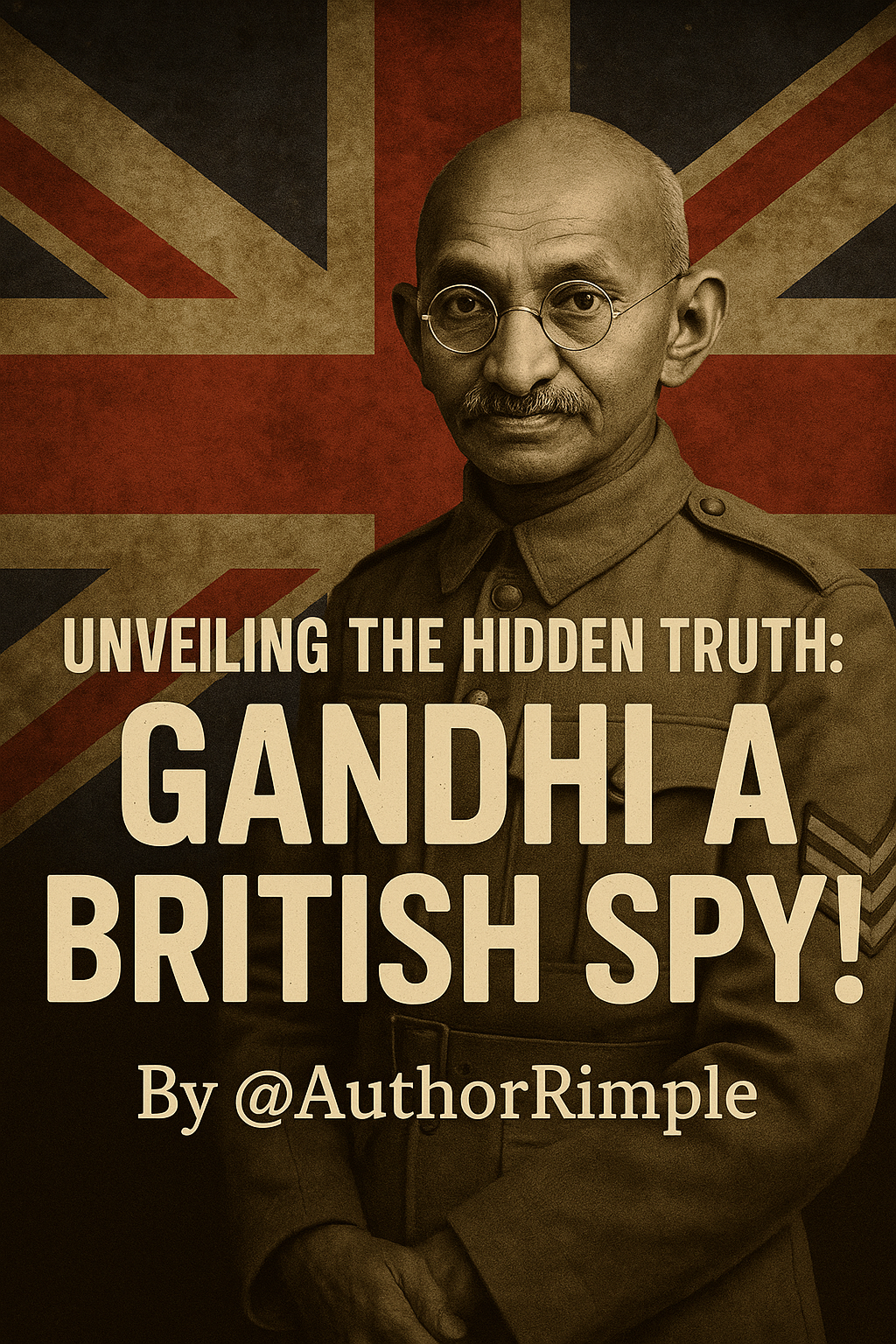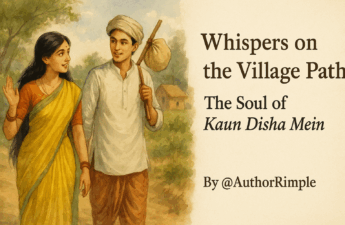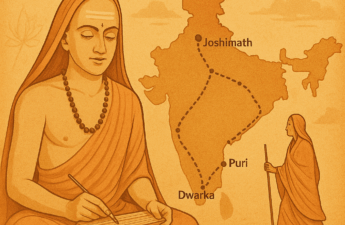Mohandas Karamchand Gandhi, often called Mahatma Gandhi, is celebrated as the “Father of the Nation” in India. His image as a saintly figure leading India to freedom through nonviolence is etched in history books. But what if this image is a carefully crafted story? What if Gandhi, the man who preached swadeshi (self-reliance) and nonviolence, was not the hero we were told he was? Instead, could he have been a British agent, strategically placed to control India’s freedom struggle and ensure British interests were protected? Let’s dive into this controversial narrative, connect the dots, and explore the unsettling questions surrounding Gandhi’s role, his connections to figures like Mirabehn, and his time as Sergeant Major Gandhi in the British Army.
Gandhi’s Early Days: A Loyal Servant of the British?
To understand this story, we need to go back to Gandhi’s early life. Born in 1869 in Gujarat, Gandhi studied law in London and later moved to South Africa in 1893 to work as a lawyer. During his time in South Africa, Gandhi served in the British Army during the Boer War (1899–1902). He wasn’t just a bystander—he held the rank of Sergeant Major and helped organize an Indian Ambulance Corps to support British troops. This is a critical point: the man who later preached nonviolence was once actively aiding the British Empire in a war, ensuring their victory. Why would someone so devoted to Indian freedom start his career serving the very empire that oppressed his people?
This wasn’t a one-time act. During World War I (1914–1918), Gandhi again supported the British. When he returned to Britain from South Africa in 1914, he declared his loyalty to the British war effort and proposed raising an Indian volunteer unit. He actively recruited Indians to fight for the British, urging young men to join the army. Historians have struggled to explain why a supposed champion of nonviolence was so eager to help the British in their wars. Some argue he was a loyalist who believed in the British system; others say he was an opportunist, hoping to gain political favors. But there’s another possibility: was Gandhi acting under British instructions to prove his loyalty and build credibility for a bigger role in India?
The Mirabehn Connection: A British Shadow by Gandhi’s Side
Now, let’s connect this to another puzzling piece of the puzzle—Mirabehn, a devoted follower of Gandhi who was always by his side. Mirabehn, born Madeleine Slade, was the daughter of Sir Edmond Slade, a high-ranking British Navy officer who served as the Commander-in-Chief of the East Indies Station. Why would the daughter of a prominent British naval officer leave her privileged life in England to live in Gandhi’s ashram in India, adopting a simple lifestyle and dedicating herself to his cause?
Mirabehn arrived in India in 1925 and quickly became one of Gandhi’s closest aides. She lived with him, traveled with him, and even served as his personal assistant. On the surface, her story seems inspiring—a British woman embracing Gandhi’s ideals of simplicity and nonviolence. But let’s look closer. Her father, Edmond Slade, was a key figure in the British Empire, deeply involved in maintaining British control over India and its surrounding regions. Is it a coincidence that the daughter of such a man became Gandhi’s shadow just as he was rising as a leader in India’s freedom movement?
There’s no direct document labeling Mirabehn a British spy, but the dots are worth connecting. The British were masters at intelligence and control. They had a history of planting agents to monitor and influence movements that threatened their rule. Could Mirabehn have been a link between Gandhi and the British, ensuring he stayed within the boundaries of what the British found acceptable? Her constant presence raises questions: was she there to support Gandhi or to keep an eye on him, reporting back to British authorities through her father’s connections? This link to the British Navy, through Edmond Slade, adds a layer of suspicion to Gandhi’s story, suggesting he was never far from British influence.
Non-violence: A British Strategy to Tame Revolutionaries
Gandhi’s philosophy of nonviolence, or Ahimsa, is central to his legacy. He urged Indians to resist British rule through peaceful protests, boycotts, and civil disobedience. But was this strategy truly his own, or was it a British tactic to weaken India’s freedom struggle? Let’s think about the context. In the early 20th century, India was a hotbed of revolutionary activity. Freedom fighters like Bhagat Singh, Chandra Shekhar Azad, Subhas Chandra Bose, and Veer Savarkar believed in armed resistance. They bombed British offices, attacked colonial officials, and inspired millions to rise against the British. These revolutionaries terrified the British, who feared a repeat of the 1857 Rebellion, when Indians nearly overthrew colonial rule.
Enter Gandhi with his message of nonviolence. His campaigns, like the Non-Cooperation Movement (1920–1922) and the Civil Disobedience Movement (1930–1934), mobilized millions but never posed a direct threat to British power. In fact, some argue Gandhi’s nonviolence acted as a “safety valve,” channeling Indian anger into peaceful protests that the British could easily manage. For example, when the Non-Cooperation Movement gained momentum, Gandhi suddenly called it off in 1922 after the Chauri Chaura incident, where a mob killed British policemen. Many revolutionaries, including Bhagat Singh, were frustrated by this decision. They believed Gandhi’s actions slowed down the fight for freedom and gave the British time to regroup.
Compare this to the fate of revolutionaries. Bhagat Singh, Rajguru, and Sukhdev were hanged in 1931 for their role in the Lahore Conspiracy Case. Chandra Shekhar Azad died in a shootout with British police. Veer Savarkar was sentenced to 50 years in the brutal Kaala Paani (Cellular Jail) in the Andaman Islands, where prisoners faced torture and starvation. Yet Gandhi and Congress leaders like Jawaharlal Nehru faced relatively lenient treatment. Gandhi was arrested multiple times but often released after short periods, they had all facilities and were allowed to live comfortably in jail. Nehru, too, spent time in prison (with all facilities and comfortably) but never faced the horrors of Kaala Paani. Why were revolutionary leaders crushed while Gandhi and Nehru were treated with kid gloves? Was it because Gandhi’s nonviolence was exactly what the British wanted—a way to pacify the masses and prevent an all-out rebellion?
Gandhi’s Luxurious Lifestyle: A Contradiction to Swadeshi
Gandhi’s public image was that of a simple man, wearing a dhoti and living a life of austerity. He championed the Swadeshi Movement, urging Indians to boycott British goods and use homespun cloth (khadi). But behind this image, there are stories of contradiction. Gandhi often traveled in luxury train compartments reserved entirely for him, even when he claimed to travel third class. He was known to have access to resources that ordinary Indians could only dream of, like special diets and medical care. Some sources claim he had three cows dedicated to providing him with fresh milk—a luxury in a country where millions starved.
Then there’s the question of his social circles. Gandhi and Nehru were often seen dining with British officials, sipping tea, and engaging in polite negotiations. They moved in elite circles, sometimes traveling in foreign cars, while revolutionaries like Bhagat Singh and Azad lived on the run, hiding from British police. This contrast is stark. If Gandhi was truly fighting for India’s freedom, why did he seem so comfortable with the British elite? Was he a bridge between the British and Indians, ensuring the British could control the freedom movement without losing their grip on India?
The British Plan to Make Gandhi a “Mahatma”
The title “Mahatma” (great soul) was first given to Gandhi in South Africa in 1914 and later popularized in India. But who promoted this image? The British had a vested interest in presenting Gandhi as a saintly figure. By elevating him as the face of India’s freedom struggle, they could divert attention from revolutionaries who posed a real threat. Gandhi’s nonviolent protests were manageable; armed uprisings were not. By calling him “Mahatma,” the British and their allies in the Indian National Congress created a larger-than-life figure who could control the masses and discourage violent resistance.
The Congress, led by Gandhi and Nehru, dominated the narrative of India’s freedom struggle. After independence in 1947, they ensured Gandhi’s image as the sole architect of freedom was cemented in history books. Revolutionary heroes like Bhagat Singh, Savarkar, and Bose were sidelined or labeled as extremists. Historians like R.C. Majumdar, who tried to write balanced accounts of the freedom struggle, were sidelined because they questioned Gandhi’s role. This suggests a deliberate effort to suppress alternative narratives and glorify Gandhi as the “Father of the Nation.”
Connecting the Dots: Gandhi was a British Setup
Let’s piece it all together. Gandhi’s early loyalty to the British as Sergeant Major Gandhi shows he was willing to serve the empire. His connection to Mirabehn, the daughter of a British Navy officer, raises questions about British influence in his inner circle. His nonviolent philosophy, while inspiring, conveniently aligned with British interests by preventing a full-scale revolution. His comfortable lifestyle and lenient treatment by the British contrast sharply with the brutal punishment faced by revolutionaries. And the “Mahatma” title, promoted by the British and Congress, ensured Gandhi’s image overshadowed the sacrifices of others.
There’s no single document that directly says, “Gandhi was a British spy.” But history is about connecting the dots. The British were experts at controlling colonies through subtle manipulation. They didn’t need to fight India head-on; they could use figures like Gandhi to manage the situation from within. By making Gandhi a national hero, they ensured India’s freedom came on their terms—through negotiations, not rebellion. The real heroes, like Bhagat Singh, Azad, and Savarkar, paid with their lives, while Gandhi and Nehru became the faces of victory.
Why This Matters Today?
This narrative isn’t about tearing down Gandhi’s legacy but about questioning the stories we’ve been told. History is often written by the victors, and in India’s case, the Congress and British shaped the story of independence.
For every layman reading this, think about it: why do we know so much about Gandhi but so little about the revolutionaries who died for our freedom? Why was Gandhi’s path of non-violence glorified while the sacrifices of others were downplayed?
The truth may be uncomfortable, but it’s worth exploring. Gandhi’s role as a British agent may not be proven beyond doubt, but the evidence—his military service, his British connections, his lenient treatment, and the suppression of revolutionary voices—raises serious questions. Perhaps Gandhi wasn’t the saint we were taught to worship. Perhaps he was a man caught in a larger British plan to control India’s destiny.
Let’s honor all our freedom fighters, not just the ones chosen by history’s pen. Bhagat Singh, Savarkar, Azad, and countless others deserve their place in our hearts. As we reflect on India’s past, let’s seek the truth, no matter how hidden it may be.





